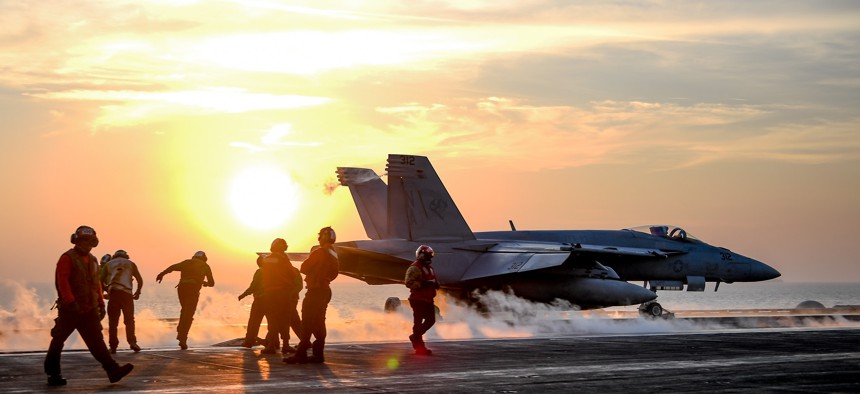
An F/A-18E Super Hornet launches from the flight deck of the aircraft carrier USS Theodore Roosevelt in the Persian Gulf, Feb. 5, 2018. U.S. Navy / Mass Communication Specialist 3rd Class Spencer Roberts
Top Admiral: Defense Firms Are Lobbying Against the Weapons the US Navy Needs
Adm. Mike Gilday also accused companies of slow-rolling ship repair.
Updated: 4:10 p.m.
The U.S. Navy’s top admiral accused defense companies of slow-rolling the production of certain weapons, moving too slowly on ship repairs, and lobbying against newer types of ships and aircraft that are needed to compete with China.
“Although it's in industry's best interest…building the ships that you want to build, lagging on repairs to ships and to submarines, lobbying Congress to buy aircraft that we don't need, that excess to need, it's not helpful,” Adm. Mike Gilday, chief of naval operations said Monday. “It really isn't, in a budget-constrained environment.”
Gilday spoke at the start of the Navy League’s 2021 Sea Air Space convention, the first large defense trade show held in-person since the pandemic began last year.
The Navy wants to stop buying Boeing-made F/A-18 Super Hornets (Congress is expected to add $1 billion to buy another batch). It also has slowed its purchase of Arleigh Burke-class destroyers. General Dynamics’ Bath Iron Works has said it will lay off thousands of shipyard workers—about 1,500 though layoffs and 1,000 through retirements—before the 2024 presidential election if the Biden administration does not place a long-term order for at least 15 Burke destroyers by 2023. Bath is at least six months behind schedule on ship construction. It is one of two companies that builds the Burkes, along with Huntington Ingalls Industries.
“One of the things, I think, where industry can really help us is to be a bit more agile in pivoting to new technologies and new platforms,” Gilday said. “It's not the ’90s anymore, as we go to the tri-service [maritime] strategy and really try to punctuate the sense of urgency that we feel every day against China to move the needle in a bureaucracy that's really not designed to move very fast.”
Military leaders have been calling for new types of next-generation ships and warplanes to counter Chinese and Russian advancements. But these projects, like a new class of destroyer and sixth-generation warplane are a decade or more from entering serial production. Congress routinely opposes military officials’ calls to retire existing weapons and end production of new ones.
Gilday said the Navy needs to regularly include industry executives and lawmakers in its wargames to better show how existing weapons stack up against global threats.
“About a year ago, the Navy spent a day with industry leaders, showing them the results of some of our wargaming,” he said. “I think that was really, really instructive. We need to do that again...and we need to do more of it not only with industry, but with the Hill.”
The Biden administration has launched several reviews that are expected to lay out its plan to modernize the military. The Pentagon’s China Task Force, global policy review, and a new joint warfighting concept will dictate what the Navy buys moving forward, Gilday said.
“[T]they're really gonna define what we buy in the future, what we invest in, because they're going to have a significant effect on how we're going to fight [and] how we're going to shape the fight,” he said.
In a statement, the National Defense Industrial Association said, "NDIA and its members fully understand and support the Navy’s need to modernize for the future while maintaining readiness today, working hard every day to provide the best systems and services to our warfighters. That is done in a difficult environment of budget instability, changing requirements and the workforce challenges of the COVID pandemic. We applaud Admiral Gilday’s call for — and we’re eager to participate in — closer coordination and collaboration between industry and the Navy considering an increasingly intense great power competition."
Caitlin Kenney contributed to this report.
